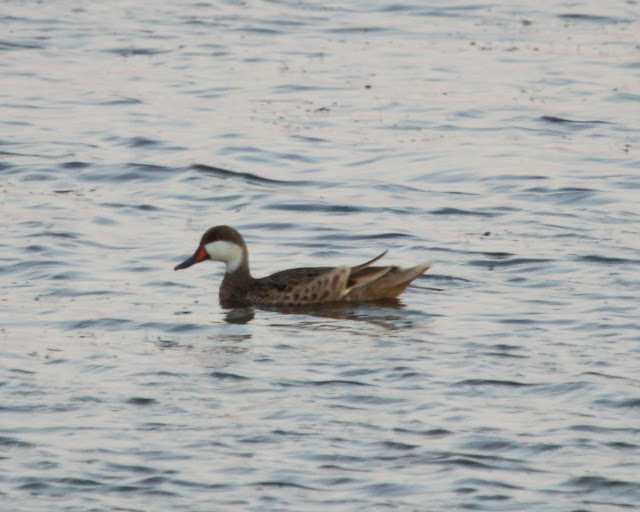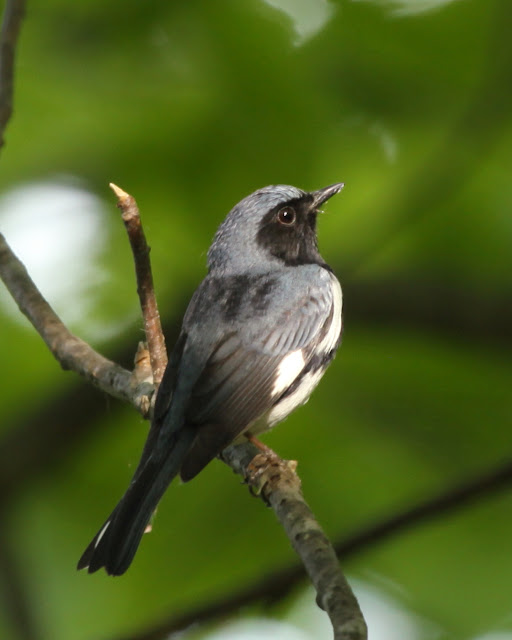This year I decided to attempt accounting for the number of ABA species I accumulated for the year. I thought I was on a roll starting in January when I visited my parents in the Lower Rio Grande Valley where I picked up multiple lifers including 4 rarities. However, somewhere along the way other aspects of life took over and I missed seeing several migrant warblers as well as a few other birds. So despite two trips to "the valley" and another to the Gulf Stream on Brian Patteson's Cape Hatteras pelagic birding tour, I still only topped out in the 330s. I think the real story may be the number of life birds I picked up this year...Or even better I learned it's not just about seeing the birds, but it's the stories you hear along the way and the people you meet. Also as one seasoned "chaser" told me, "it wouldn't be as exciting if you actually saw EVERY bird you chased." Well maybe. I'm not so sure about that one.
Anyway, here is a collection of some of those lifers, plus a few of my top bird photos and/or sightings from 2010.
Anyway, here is a collection of some of those lifers, plus a few of my top bird photos and/or sightings from 2010.
#1 Amazon Kingfisher (lifer)
This bird was an ABA first record seen January 24, 2009-February 3, 2010 on the banks of Zacate Creek where it flows into the Rio Grande in Laredo, TX. My parents and I went to see this bird on February 1 . We waited over 3 hours with many chasers for the bird to make a 5 minute or so appearance just before sunset.
#2 Northern Jacana (lifer)
My dad and I went on a Texas rarity chase on February 4 for two birds. Our first stop was Choke Canyon State Park to try for the Northern Jacana. At Choke Canyon, we met a nice park ranger with an interesting life story about his former work along the Mexican border fighting the drug cartels. In addition to the jacana, Choke Canyon proved to be good place to see Verdin and multiple wren species. The ranger also informed us he had Painted Bunting on his early morning bird count, but we missed spotting this species due to time constraints (last time I saw this species was 1995).
#3 Northern Wheatear (lifer)

Our second stop on February 4 was the Amish farm and homestead of John Borntrager for the Northern Wheatear in southwestern Bee County, TX. John had found this bird back on December 30,2009. The bird popped into view immediately upon our arrival, atop a pile of scrap wood and sticks. We visited the farm for about 45 minutes. While I photographed the bird, my dad 'chewed the cud' with the farmer, picking his brain about Amish life. We learned through conversation with John, his family owned a store down the road, the Borntrager Combination Shop. So after visiting the wheatear we headed to the store where we picked up some homemade items which included lip balm, jams and knit drink coasters.
#4 Crimson Collared Grosbeak (lifer)
During the same early February trip to the Rio Grande Valley, a male Crimson Collared Grosbeak was making a showing foraging on potato vines at Quinta Mazatlan. We searched the grounds for about an hour when the bird was briefly located by another birder. About 20 minutes later the bird re-appeared near the complex entrance and we were treated to excellent views for greater than 30 minutes. On this occasion, we also got to witness how people bend birding ethics, trampling vegetation, nudging others out of the way and flushing the bird just to get photos of a spectacularly colored rarity...
#5 Tropical/Northern Parula hybrid
During our search for the Crimson Collared Grosbeak, I found what I presumed was an easy lifer Tropical Parula coming to the oranges at Quinta Mazatlan. As I rookie to Lower Rio Grande Valley birding I did not overly scrutinize the identification of this species and assumed it was a Tropical Parula as reported to various Texas Rare Bird sites. However subsequent discussion indicates this bird was not my lifer Tropical Parula but more likely a hybrid Tropical/Northern Parula. Boooo.
#6 Clay-Colored Robin (lifer)
Not the prettiest bird, but a lifer nonetheless. This bird was seen at the Bentsen-Rio Grande Valley State Park peanut butter suet feeder. I learned during this early February trip that the Rio Grande Valley is much birdier earlier in the winter as opposed to late March when I visited in 2009. Birds such as the Clay-colored Robin were much easier to see in winter vs. when spring approaches in the Valley.
#7 Rose-throated Becard
Not a lifer, but this was only the 2nd time I've seen this bird. He was coming to the suet feeders at the entrance to Bentsen. This was a much better look than the lifer I had at Estero Llanno Grande in 2009.
#8 Brown Jay (lifer)
On my second trip back to Texas in March, myself, spouse and parents chased this bird. He was coming to a private residence in Zapata. The owners were gracious in allowing us to sit on their back patio while we waited for the bird. The bird never came to their tortilla feeders (yes the bird was known to have a hankering for tortillas), but we were fortunate to spot him among the bramble of trees just outside the property where we had been patiently waiting for him. Traveling the back streets of Zapata provided a glimpse into a town that distinctly resembled a third world country with its narrow dirt and pot-holed streets lined by degraded stucco homes. It was definitely one of those "you're not in Kansas anymore" moments. However, despite the obvious poverty, there was still an artistic romanticism to the town's unique architecture and landscaping in this different and small slice of America.
#9, #10, #11, #12, #13 ...
The next five species were seen on Brian Patteson's pelagic bird watching trip in the Gulf Stream out of Hatteras, NC. Yes, the water is really that blue in the Gulf Stream. In fact there is a clear demarcation between the deep cobalt blue of gulf as opposed to the blue green waters closer inland.
 |
| #10 Greater Shearwater (lifer) |
 |
| #11 Audubon's Shearwater (lifer) |
 |
| #12 Cory's Shearwater (lifer) |
 |
| #13 Bridled Tern |
 |
| This bird landed on the boat for 45+ minutes. When he took flight the captain tossed him a boat cushion for refuge. |
 |
| #14 Red Phalarope (lifer) Seen at South Metro Pier in Milwaukee County, WI during the Madison Audubon Society Lakeshore Birding Trip on November 7 |
#15 Great Gray Owl
Seeing the Great Gray this year was my third and by far best view. I had previously seen "him" in 2009 in the Sax-Zim bog and before that in 1996 in the Fremont National Forest in southern Oregon. In 2010, this bird was seen on our annual winter bird watching trip to the Duluth area in Minnesota. We had searched for this bird, dawn and dusk for 3 days without success. Unable to resign our hopes of seeing a Great Gray Owl before heading back to southern Wisconsin, we decided to brave the snow-covered roads and make one last run for the bird at dawn on our day of departure. The effort paid off. We watched this bird for 38 minutes in a fairly substantial snowfall.
#16 Thayer's Gull (lifer)
Our last stop in the Duluth area in January was Canal Park where I found this lifer with the help of local larophiles.
#17 White-cheeked Pintail (Not accepted as a wild bird)
Following our pelagic birding trip from Hatteras, NC we bee-lined it to Pea Island NWR where this White-cheeked Pintail was being seen. The jury is out as to whether it will be accepted as a wild bird and therefore ABA countable. Odds are with waterfowl such as this species that it will not be accepted as a wild bird. Update 11/16/2013 This bird was not accepted as a wild bird.
#18 Anna's Hummingbird (lifer)
Lastly a few gems from this spring in the north...
#19 Black-throated Blue Warbler
The bluff overlooking Spectacle Lake in Chippewa County Michigan affords excellent warbler viewing and photography as one is positioned at or above the tree tops where the birds are often seen at close range.
It's always an added treat to capture a warbler singing, let alone a Black-throated Blue Warbler singing.
#20 Blackburnian Warbler
At Monocle Lake, located in the valley below Spectacle Lake, I found this Blackburnian Warbler perched a few feet off the ground, ruffling it's feathers after a bath in the creek.















No comments:
Post a Comment